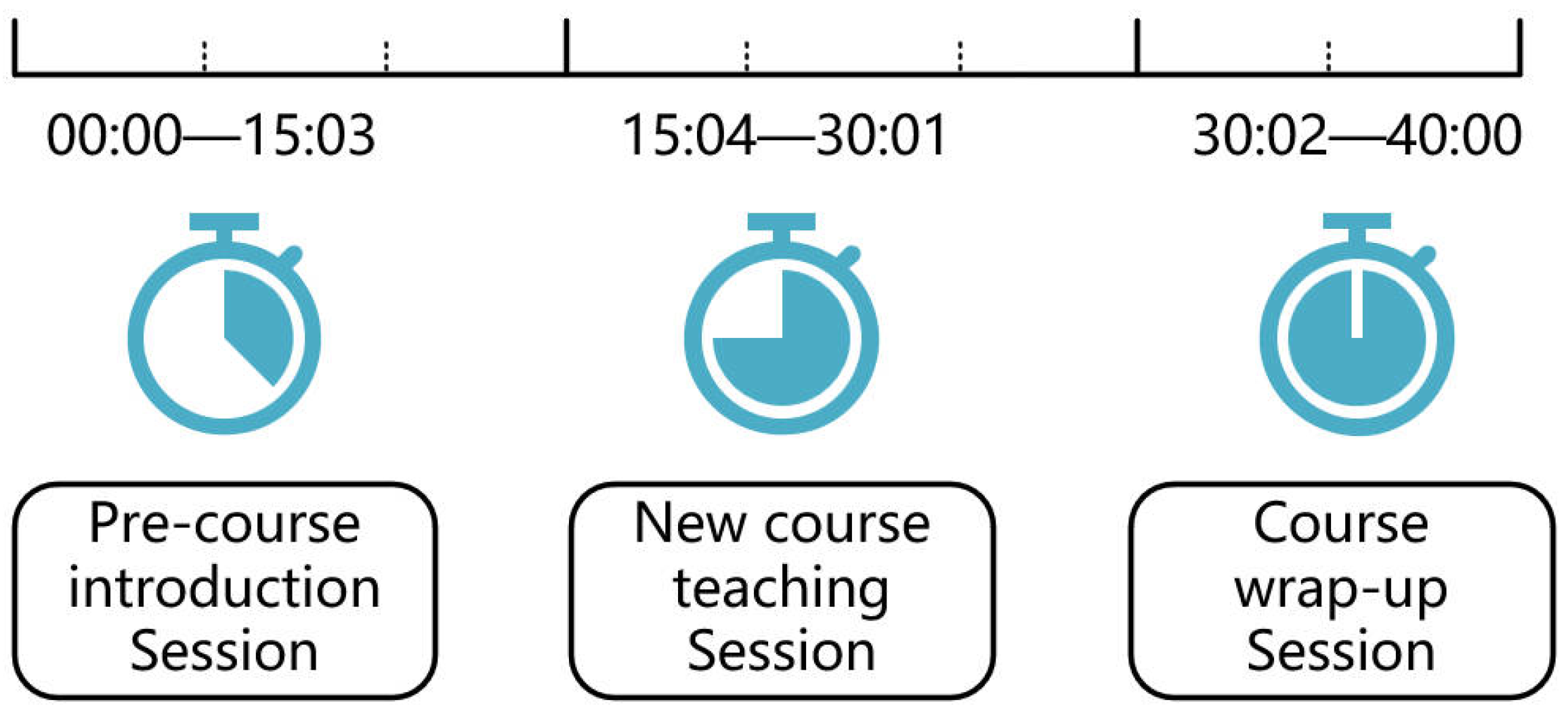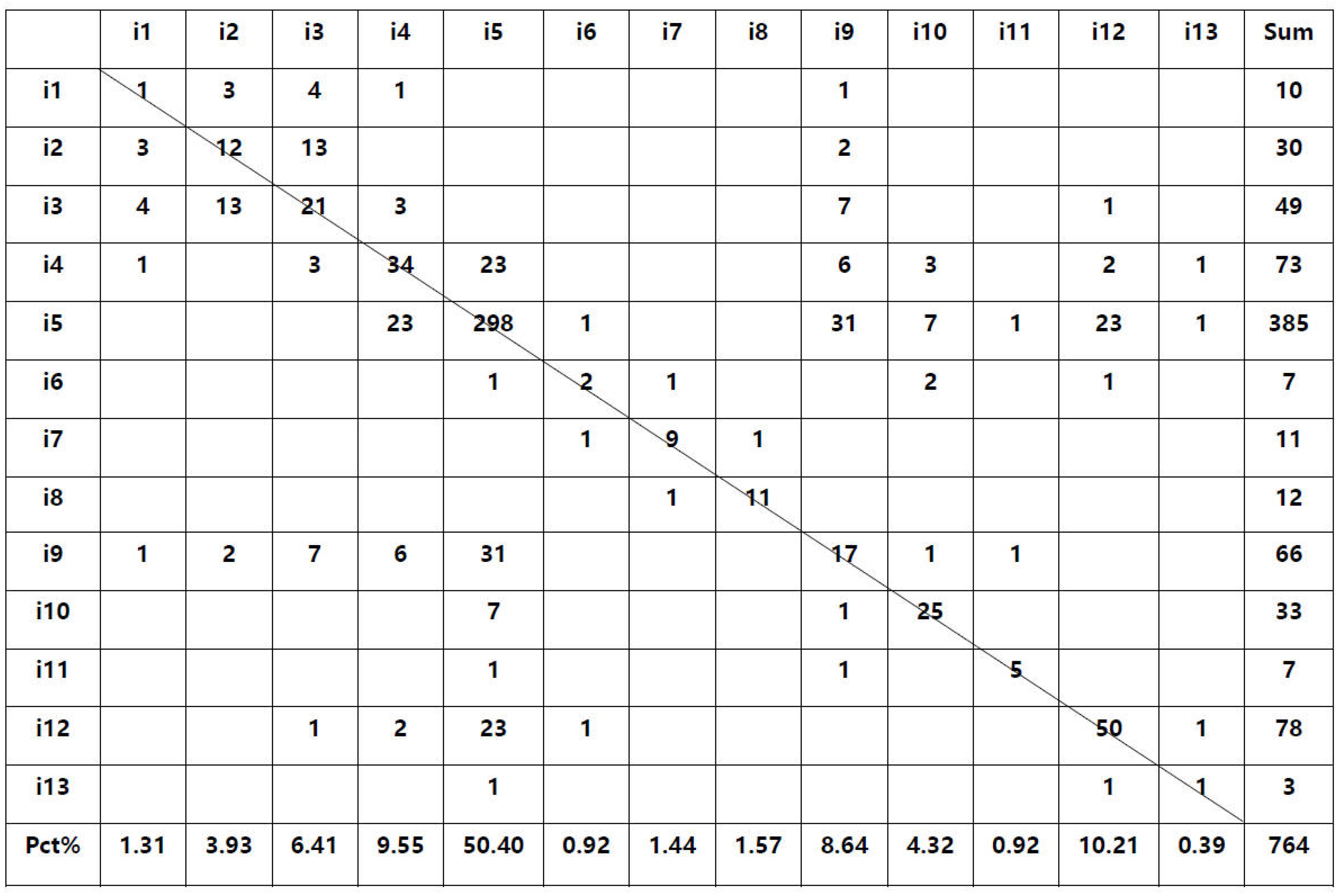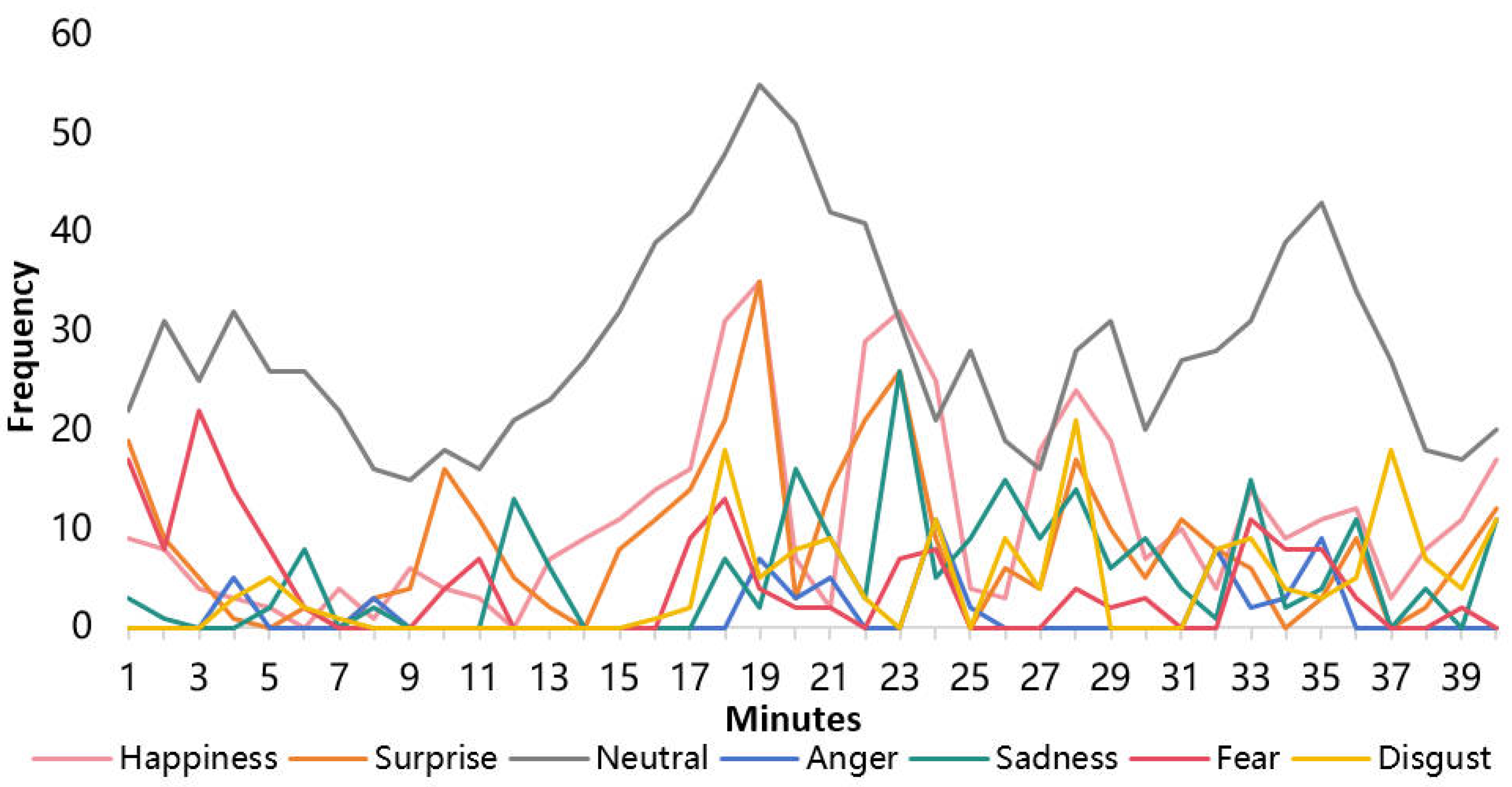Investigating the Emotion Patterns of Students’ Abnormal Interactions in Primary Class Teaching Contexts
Abstract
:1. Introduction
2. Literature Review
2.1. Student Abnormal Interactions in Classes
2.2. Student Emotions in Classes
2.3. Research Questions
- What are the forms and manifestations of students’ abnormal interactions in class teaching?
- What are the characteristics of students’ emotions in class teaching?
- What are the emotion patterns of students’ abnormal interactions in class teaching?
3. Methods
3.1. Research Design
3.2. Participants
3.3. Course Setting
3.4. Coding Scheme
3.4.1. Coding Scheme for Students’ Abnormal Interactions
3.4.2. Coding Scheme for Student Interaction Emotions
3.5. Data Analysis
4. Results
4.1. Students’ Abnormal Interactions
4.2. Students’ Dynamic Emotions
4.3. Students’ Emotions in Abnormal Interactions
5. Discussion
5.1. Students’ Abnormal Interactions in Class Teaching
5.2. Students’ Emotions in Class Teaching
5.3. Emotion Patterns of Students’ Abnormal Interactions
5.4. Implications
5.5. Limitations and Future Research
6. Conclusions
Author Contributions
Funding
Institutional Review Board Statement
Informed Consent Statement
Data Availability Statement
Conflicts of Interest
References
- Howe, C.; Abedin, M. Classroom dialogue: A systematic review across four decades of research. Camb. J. Educ. 2013, 43, 325–356. [Google Scholar] [CrossRef]
- Premo, J.; Cavagnetto, A. Priming students for whole-class interaction: Using interdependence to support behavioral engagement. Soc. Psychol. Educ. 2018, 21, 915–935. [Google Scholar] [CrossRef]
- Sugai, G.; Horner, R.H. What we know and need to know about preventing problem behavior in schools. Exceptionality 2008, 16, 67–77. [Google Scholar] [CrossRef]
- Lazarus, R.S. Progress on a cognitive-motivational-relational theory of emotion. Am. Psychol. 1991, 46, 819. [Google Scholar] [CrossRef] [PubMed]
- Bell, M.A.; Wolfe, C.D. Emotion and cognition: An intricately bound developmental process. Child Dev. 2004, 75, 366–370. [Google Scholar] [CrossRef]
- Bhardwaj, P.; Gupta, P.; Panwar, H.; Siddiqui, M.K.; Morales-Menendez, R.; Bhaik, A. Application of deep learning on student engagement in e-learning environments. Comput. Electr. Eng. 2021, 93, 107277. [Google Scholar] [CrossRef] [PubMed]
- Kwon, K.; Liu, Y.H.; Johnson, L.P. Group regulation and social-emotional interactions observed in computer supported collaborative learning: Comparison between good vs. poor collaborators. Comput. Educ. 2014, 78, 185–200. [Google Scholar] [CrossRef]
- Li, J.; Xue, E. Unpacking the Policies, Historical Stages, and Themes of the Education Equality for Educational Sustainable Development: Evidence from China. Sustainability 2022, 14, 10522. [Google Scholar] [CrossRef]
- Eron, L.D.; Peterson, R.A. Abnormal behavior: Social approaches. Annu. Rev. Psychol. 1982, 33, 231–264. [Google Scholar] [CrossRef]
- Ryan, D.P.J. Bronfenbrenner’s Ecological Systems Theory. Available online: https://dropoutprevention.org/wp-content/uploads/2015/07/paquetteryanwebquest_20091110.pdf (accessed on 16 September 2023).
- Lu, M.; Li, D.; Xu, F. Recognition of students’ abnormal behaviors in English learning and analysis of psychological stress based on deep learning. Front. Psychol. 2022, 13, 1025304. [Google Scholar] [CrossRef]
- Orban, S.A.; Rapport, M.D.; Friedman, L.M.; Eckrich, S.J.; Kofler, M.J. Inattentive behavior in boys with ADHD during classroom instruction: The mediating role of working memory processes. J. Abnorm. Child Psychol. 2018, 46, 713–727. [Google Scholar] [CrossRef]
- Sutherland, K.S.; Conroy, M.A.; Algina, J.; Ladwig, C.; Jessee, G.; Gyure, M. Reducing child problem behaviors and improving teacher-child interactions and relationships: A randomized controlled trial of BEST in CLASS. Early Child. Res. Q. 2018, 42, 31–43. [Google Scholar] [CrossRef]
- Cothran, D.J.; Kulinna, P.H.; Garrahy, D.A. Attributions for and consequences of student misbehavior. Phys. Educ. Sport Pedagog. 2009, 14, 155–167. [Google Scholar] [CrossRef]
- Harrison, J.R.; Vannest, K.; Davis, J.; Reynolds, C. Common problem behaviors of children and adolescents in general education classrooms in the United States. J. Emot. Behav. Disord. 2012, 20, 55–64. [Google Scholar] [CrossRef]
- Xie, Y.; Zhang, S.; Liu, Y. Abnormal Behavior Recognition in Classroom Pose Estimation of College Students Based on Spatiotemporal Representation Learning. Trait. Signal 2021, 38, 89–95. [Google Scholar] [CrossRef]
- Zhang, C.; Jin, C.; Li, Y. Abnormal behavior recognition of experimental process based on improved YOLOV4. In Proceedings of the International Conference on Electronic Information Engineering and Data Processing (EIEDP 2023), Nanchang, China, 17–19 March 2023; Volume 12700, pp. 498–505. [Google Scholar]
- Yuan, X.; Che, L. How to deal with student misbehaviour in the classroom? J. Educ. Dev. Psychol. 2012, 2, 143. [Google Scholar] [CrossRef]
- Buyse, E.; Verschueren, K.; Doumen, S.; Van Damme, J.; Maes, F. Classroom problem behavior and teacher-child relationships in kindergarten: The moderating role of classroom climate. J. Sch. Psychol. 2008, 46, 367–391. [Google Scholar] [CrossRef]
- Flórez Marulanda, J.F.; Collazos, C.A.; Hurtado, J.A. Evaluating an Immersive Virtual Classroom as an Augmented Reality Platform in Synchronous Remote Learning. Information 2023, 14, 543. [Google Scholar] [CrossRef]
- Castro, V.L.; Cooke, A.N.; Halberstadt, A.G.; Garrett-Peters, P. Bidirectional linkages between emotion recognition and problem behaviors in elementary school children. J. Nonverbal Behav. 2018, 42, 155–178. [Google Scholar] [CrossRef]
- Webb, N.M. Predicting learning from student interaction: Defining the interaction variables. Educ. Psychol. 1983, 18, 33–41. [Google Scholar] [CrossRef]
- Camacho, D.A.; Moore, S.A.; Pas, E.T.; Bradshaw, C.P. Interactional quality in middle schools: Latent profiles and their associations with teacher, classroom, and school compositional factors. J. Sch. Psychol. 2022, 93, 79–97. [Google Scholar] [CrossRef]
- Zheng, L.; Huang, R. The effects of sentiments and co-regulation on group performance in computer supported collaborative learning. Internet High. Educ. 2016, 28, 59–67. [Google Scholar] [CrossRef]
- White, C.J. Higher education emotions: A scale development exercise. High. Educ. Res. Dev. 2013, 32, 287–299. [Google Scholar] [CrossRef]
- Govaerts, S.; Grégoire, J. Development and construct validation of an academic emotions scale. Int. J. Test. 2008, 8, 34–54. [Google Scholar] [CrossRef]
- Camacho-Morles, J.; Slemp, G.R.; Pekrun, R.; Loderer, K.; Hou, H.; Oades, L.G. Activity achievement emotions and academic performance: A meta-analysis. Educ. Psychol. Rev. 2021, 33, 1051–1095. [Google Scholar] [CrossRef]
- Goetz, T.; Frenzel, A.C.; Hall, N.C.; Nett, U.E.; Pekrun, R.; Lipnevich, A.A. Types of boredom: An experience sampling approach. Motiv. Emot. 2014, 38, 401–419. [Google Scholar] [CrossRef]
- Putwain, D.W.; Wood, P.; Pekrun, R. Achievement emotions and academic achievement: Reciprocal relations and the moderating influence of academic buoyancy. J. Educ. Psychol. 2022, 114, 108. [Google Scholar] [CrossRef]
- Lovos, E.; Aballay, L. Deserción Academica y Emociones en Ambientes E-learning. Rev. Iberoam. Tecnol. Educ. Educ. Tecnol. 2020, 27, 89–94. [Google Scholar] [CrossRef]
- Estrada, M.L.B.; Cabada, R.Z.; Bustillos, R.O.; Graff, M. Opinion mining and emotion recognition applied to learning environments. Expert Syst. Appl. 2020, 150, 113265. [Google Scholar] [CrossRef]
- Tonguç, G.; Ozkara, B.O. Automatic recognition of student emotions from facial expressions during a lecture. Comput. Educ. 2020, 148, 103797. [Google Scholar] [CrossRef]
- Pekrun, R.; Linnenbrink-Garcia, L. International Handbook of Emotions in Education; Routledge: London, UK, 2014. [Google Scholar]
- Gasser, L.; Grütter, J.; Buholzer, A.; Wettstein, A. Emotionally supportive classroom interactions and students’ perceptions of their teachers as caring and just. Learn. Instr. 2018, 54, 82–92. [Google Scholar] [CrossRef]
- Madill, R.A.; Gest, S.D.; Rodkin, P.C. Students’ perceptions of relatedness in the classroom: The roles of emotionally supportive teacher–child interactions, children’s aggressive–disruptive behaviors, and peer social preference. Sch. Psychol. Rev. 2014, 43, 86–105. [Google Scholar] [CrossRef]
- Bradley, R.; Doolittle, J.; Bartolotta, R. Building on the data and adding to the discussion: The experiences and outcomes of students with emotional disturbance. J. Behav. Educ. 2008, 17, 4–23. [Google Scholar] [CrossRef]
- Mason, W.A.; Lambert, M.C.; Epstein, M.H. Differences in emotional and behavioral problems of students over time: A 22-Year Cross-Sectional Cohort Study. Res. Child Adolesc. Psychopathol. 2023, 51, 557–569. [Google Scholar] [CrossRef]
- Aballay, L.N.; Aciar, S.V.; Collazos, C.A. Emotions for virtual learning environments. IEEE Rev. Iberoam. Tecnol. Aprendiz. 2021, 16, 215–224. [Google Scholar] [CrossRef]
- Searle, A.K.; Sawyer, M.G.; Miller-Lewis, L.R.; Baghurst, P.A. Prospective associations between children’s preschool emotional and behavioral problems and kindergarten classroom engagement, and the role of gender. Elem. Sch. J. 2014, 114, 380–405. [Google Scholar] [CrossRef]
- Flanders, N.A. Intent, action and feedback: A preparation for teaching. J. Teach. Educ. 1963, 14, 251–260. [Google Scholar] [CrossRef]
- Martinek, T.J.; Mancini, V.H. CAFIAS: Observing dyadic interaction between teacher and student. J. Classr. Interact. 1979, 14, 18–23. [Google Scholar]
- Fang, H.; Gao, C.; Chen, J. Improved Flanders interactive analysis system and its application. China Educ. Technol. 2012, 10, 109–113. [Google Scholar]
- Fernández-Caballero, A.; Martínez-Rodrigo, A.; Pastor, J.M.; Castillo, J.C.; Lozano-Monasor, E.; López, M.T.; Zangróniz, R.; Latorre, J.M.; Fernández-Sotos, A. Smart environment architecture for emotion detection and regulation. J. Biomed. Inform. 2016, 64, 55–73. [Google Scholar] [CrossRef]
- Goetz, T.; Lüdtke, O.; Nett, U.E.; Keller, M.M.; Lipnevich, A.A. Characteristics of teaching and students’ emotions in the classroom: Investigating differences across domains. Contemp. Educ. Psychol. 2013, 38, 383–394. [Google Scholar] [CrossRef]
- Bunce, D.M.; Flens, E.A.; Neiles, K.Y. How long can students pay attention in class? A study of student attention decline using clickers. J. Chem. Educ. 2010, 87, 1438–1443. [Google Scholar] [CrossRef]
- Wilson, K.; Korn, J.H. Attention during lectures: Beyond ten minutes. Teach. Psychol. 2007, 34, 85–89. [Google Scholar] [CrossRef]
- Algozzine, K.; Christian, C.; Marr, M.B.; McClanahan, T.; White, R. Demography of problem behavior in elementary schools. Exceptionality 2008, 16, 93–104. [Google Scholar] [CrossRef]
- Sedova, K.; Navratilova, J. Silent students and the patterns of their participation in classroom talk. J. Learn. Sci. 2020, 29, 681–716. [Google Scholar] [CrossRef]
- Sandstrom, G.M.; Rawn, C.D. Embrace chattering students: They may be building community and interest in your class. Teach. Psychol. 2015, 42, 227–233. [Google Scholar] [CrossRef]
- Beaujean, A.A. Latent Variable Modeling Using R: A Step-by-Step Guide; Routledge: London, UK, 2014. [Google Scholar]
- Kokkinos, C.M.; Panayiotou, G.; Davazoglou, A.M. Perceived seriousness of pupils’ undesirable behaviours: The student teachers’ perspective. Educ. Psychol. 2004, 24, 109–120. [Google Scholar] [CrossRef]
- Epstein, M.; Atkins, M.; Cullinan, D.; Kutash, K.; Weaver, K. Reducing behavior problems in the elementary school classroom. IES Pract. Guide 2008, 20, 12–22. [Google Scholar]
- Kirkpatrick, M.; Rivera, G.; Akers, J. Systematic review of behavioral interventions using digital technology to reduce problem behavior in the classroom. J. Behav. Educ. 2022, 31, 69–93. [Google Scholar] [CrossRef]
- Miller, L.M.; Dufrene, B.A.; Sterling, H.E.; Olmi, D.J.; Bachmayer, E. The effects of check-in/check-out on problem behavior and academic engagement in elementary school students. J. Posit. Behav. Interv. 2015, 17, 28–38. [Google Scholar] [CrossRef]
- Kiesner, J. Depressive symptoms in early adolescence: Their relations with classroom problem behavior and peer status. J. Res. Adolesc. 2002, 12, 463–478. [Google Scholar] [CrossRef]
- Sharma, P.; Joshi, S.; Gautam, S.; Filipe, V.; Reis, M. Student engagement detection using emotion analysis, eye tracking and head movement with machine learning. arXiv 2019, arXiv:1909.12913. [Google Scholar]
- Reyes, M.R.; Brackett, M.A.; Rivers, S.E.; White, M.; Salovey, P. Classroom emotional climate, student engagement, and academic achievement. J. Educ. Psychol. 2012, 104, 700. [Google Scholar] [CrossRef]
- Valiente, C.; Swanson, J.; Eisenberg, N. Linking students’ emotions and academic achievement: When and why emotions matter. Child Dev. Perspect. 2012, 6, 129–135. [Google Scholar] [CrossRef] [PubMed]
- Tan, J.; Mao, J.; Jiang, Y.; Gao, M. The influence of academic emotions on learning effects: A systematic review. Int. J. Environ. Res. Public Health 2021, 18, 9678. [Google Scholar] [CrossRef]
- Barbier, K.; Struyf, E.; Verschueren, K.; Donche, V. Fostering cognitive and affective-motivational learning outcomes for high-ability students in mixed-ability elementary classrooms: A systematic review. Eur. J. Psychol. Educ. 2023, 38, 83–107. [Google Scholar] [CrossRef]
- Hirvonen, R.; Putwain, D.W.; Määttä, S.; Ahonen, T.; Kiuru, N. The role of academic buoyancy and emotions in students’ learning-related expectations and behaviours in primary school. Br. J. Educ. Psychol. 2020, 90, 948–963. [Google Scholar] [CrossRef]
- Thuen, E.; Bru, E. Are Changes in Students’ Perceptions of the Learning Environment Related to Changes in Emotional and Behavioural Problems? Sch. Psychol. Int. 2009, 30, 115–136. [Google Scholar] [CrossRef]
- Adamson, L. Fear and shame: Students’ experiences in English-medium secondary classrooms in Tanzania. J. Multiling. Multicult. Dev. 2022, 1–16. [Google Scholar] [CrossRef]
- Méndez López, M.G.; Peña Aguilar, A. Emotions as learning enhancers of foreign language learning motivation. Profile Issues Teach. Dev. 2013, 15, 109–124. [Google Scholar]
- Heerdink, M.W.; Koning, L.F.; Van Doorn, E.A.; Van Kleef, G.A. Emotions as guardians of group norms: Expressions of anger and disgust drive inferences about autonomy and purity violations. Cogn. Emot. 2019, 33, 563–578. [Google Scholar] [CrossRef] [PubMed]
- Oliver, K.; Osborne, J.; Brady, K. What are secondary students’ expectations for teachers in virtual school environments? Distance Educ. 2009, 30, 23–45. [Google Scholar] [CrossRef]
- Do, S.L.; Schallert, D.L. Emotions and Classroom Talk: Toward a Model of the Role of Affect in Students’ Experiences of Classroom Discussions. J. Educ. Psychol. 2004, 96, 619. [Google Scholar] [CrossRef]
- Krapp, A. Basic needs and the development of interest and intrinsic motivational orientations. Learn. Instr. 2005, 15, 381–395. [Google Scholar] [CrossRef]
- Herman, K.C.; Reinke, W.M.; Dong, N.; Bradshaw, C.P. Can effective classroom behavior management increase student achievement in middle school? Findings from a group randomized trial. J. Educ. Psychol. 2022, 114, 144. [Google Scholar] [CrossRef]
- Busacca, M.L.; Anderson, A.; Moore, D.W. Self-management for primary school students demonstrating problem behavior in regular classrooms: Evidence review of single-case design research. J. Behav. Educ. 2015, 24, 373–401. [Google Scholar] [CrossRef]





| Teacher interaction | Response | i1. Accepts feelings | Accepts or clarifies the attitudes of students. |
| i2. Praises or encourages | Praises or encourages students behavior or performance. | ||
| i3. Accepts or uses ideas of student | Adopts and develops student perspectives. | ||
| Initiation | i4. Asks questions | Asks students questions about the content. | |
| i5. Lecturing | Gives facts or opinions about the course content. | ||
| i6. Giving directions | Gives instructions or orders to students. | ||
| i7. Criticizing or justifying authority | Criticizes to correct unacceptable student behavior. | ||
| Student interaction | Response | i8. Student talk response | Responds to the teacher’s questions. |
| i9. Student talk nonresponse | Nonresponse to the teacher’s questions. | ||
| i10. Student disobeys instructions | Disobeys the teacher’s instructions or orders. | ||
| Initiation | i11. Student talk initiation | Student expresses views under teacher’s permission. | |
| i12. Students chat without permission | Students chat without teacher’s permission. | ||
| i13. Student disrupts the classroom | Student’s immature classroom noise and disruption. |
| Emotion | Example | Description |
|---|---|---|
| Happiness | Eyes slightly closed, mouth open, eyebrows raised. | Be interested in the subject, receive recognition and praise from teachers, etc. |
| Surprise | Eyes wide, mouth open, eyebrows raised. | Be surprised by new knowledge or concepts or ideas, etc. |
| Neutral | Blank expression or Unable to recognize. | Emotionless without other types of emotions, etc. |
| Anger | Brows furrowed, eyes wide open, lips pursed. | Dissatisfaction with class content or instruction, conflict with teacher or classmates, etc. |
| Sadness | Brow drooping, eyes dull, mouth drooping. | Tension with teachers and classmates, disinterest in learning content, high stress in learning, etc. |
| Fear | Brows furrowed, eyes wide, cheeks tense. | Uncertainty about learning outcomes, fear of failure or being judged, etc. |
| Disgust | Brows furrowed, eyes closed, lips pressed. | Dislike of course content, teaching style, or behavior of classmates, etc. |
| Emotion | Unknown | Happiness | Surprise | Neutral | Anger | Sadness | Fear | Disgust |
|---|---|---|---|---|---|---|---|---|
| Frequency | 314 | 436 | 339 | 1148 | 58 | 217 | 168 | 171 |
| Proportion | 11.014% | 15.293% | 11.906% | 40.266% | 2.003% | 7.611% | 0.589% | 5.997% |
| Emotion | Happiness | Surprise | Neutral | Anger | Sadness | Fear | Disgust |
|---|---|---|---|---|---|---|---|
| i9 | −0.20 | −2.10 | 9.00 * | −3.00 | −1.40 | 6.20 * | −2.00 |
| i10 | −0.90 | 0.30 | 1.70 | −1.60 | −1.50 | −0.60 | 3.90 * |
| i12 | 7.60 * | 3.70 * | 0.60 | −1.20 | −1.00 | −2.30 | −1.60 |
Disclaimer/Publisher’s Note: The statements, opinions and data contained in all publications are solely those of the individual author(s) and contributor(s) and not of MDPI and/or the editor(s). MDPI and/or the editor(s) disclaim responsibility for any injury to people or property resulting from any ideas, methods, instructions or products referred to in the content. |
© 2023 by the authors. Licensee MDPI, Basel, Switzerland. This article is an open access article distributed under the terms and conditions of the Creative Commons Attribution (CC BY) license (https://creativecommons.org/licenses/by/4.0/).
Share and Cite
Han, S.; Yusupbag, D.; Yao, X.; Han, Z. Investigating the Emotion Patterns of Students’ Abnormal Interactions in Primary Class Teaching Contexts. Sustainability 2023, 15, 16785. https://doi.org/10.3390/su152416785
Han S, Yusupbag D, Yao X, Han Z. Investigating the Emotion Patterns of Students’ Abnormal Interactions in Primary Class Teaching Contexts. Sustainability. 2023; 15(24):16785. https://doi.org/10.3390/su152416785
Chicago/Turabian StyleHan, Shougang, Dilraba Yusupbag, Xinlu Yao, and Zhongmei Han. 2023. "Investigating the Emotion Patterns of Students’ Abnormal Interactions in Primary Class Teaching Contexts" Sustainability 15, no. 24: 16785. https://doi.org/10.3390/su152416785
APA StyleHan, S., Yusupbag, D., Yao, X., & Han, Z. (2023). Investigating the Emotion Patterns of Students’ Abnormal Interactions in Primary Class Teaching Contexts. Sustainability, 15(24), 16785. https://doi.org/10.3390/su152416785







